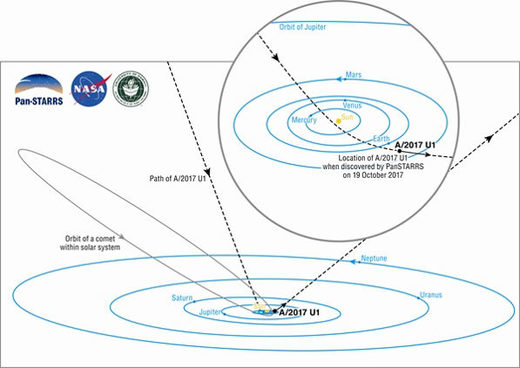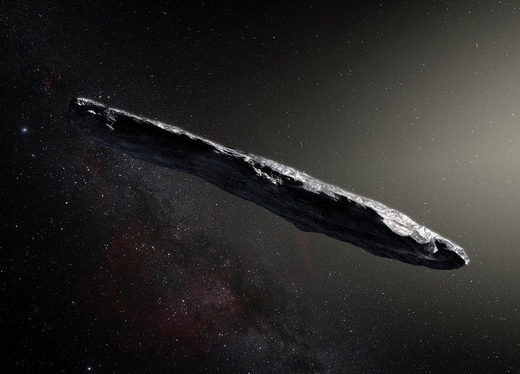But an object swept up just a week ago by observers using the PanSTARRS 1 telescope atop Haleakala on Maui has an extreme orbit — it's on a hyperbolic trajectory that doesn't appear to be bound to the Sun. Preliminary findings, published earlier today by the International Astronomical Union's Minor Planet Center (MPC), suggest that we are witnessing a body that escaped from another star.
"If further observations confirm the unusual nature of this orbit," notes Gareth Williams, the MPC's associate director, "this object may be the first clear case of an interstellar comet."
Initially designated C/2017 U1, this interloper was a dim, 20th-magnitude blip when first spotted on October 18th, after having zipped within 37,600,000 km (23,400,000 miles) of the Sun on September 9th. Such a close approach to the Sun's searing heat would ordinarily spell doom for a small comet. Based on its apparent brightness, dynamicist Bill Gray calculates that it would have a diameter of about 160 meters (525 feet) if it were a rock with a surface reflectivity of 10%. "It went past the Sun really fast," Gray notes, "and may not have had time to heat up enough to break apart."
Now it's headed out of the solar system, never to return. It passed closest to Earth on October 14th at a distance of about 24,000,000 km (15,000,000 miles), and astronomers worldwide have been tracking it in the hopes of divining its true nature — especially whether it's displaying any cometary activity.
Its true character became clearer after Karen Meech (University of Hawaii) recorded a series of images with the Very Large Telescope that, when stacked, showed a perfectly starlike object. So it's a deep-space asteroid, not a comet, and consequently officials at the MPC changed its designation to A/2017 U1.
What gave this object away as an interstellar visitor wasn't its very high inclination (122°) with respect to Earth's orbit, which isn't particularly rare, but more critically its extremely hyperbolic eccentricity (1.19).
Dynamicists had previously calculated how often comets and asteroids from other stars should be in our midst. However, the only other object suspected to have an interstellar origin was Comet Bowell (C/1980 E1), which had an eccentricity near 1.05. However, notes S&T Senior Contributing Editor Roger Sinnott, "Comet Bowell apparently was not hyperbolic on the way in, but only as it left" because that object passed within 35,000,000 km (0.23 a.u.) of Jupiter, whose gravity gave it a boost in speed.
This object entered the solar system moving at 26 km (16 miles) per second. At that speed, in 10 million years it would traverse 8,200,000,000,000,000 km — more than 850 light-years.
According to Gray, the PanSTARRS "comet" appears to have entered the solar system from the direction of the constellation Lyra, within ½° of right ascension 18h 44m, declination +34° 40′. That's 4½° from Vega — tantalizingly close and eerily reminiscent of the plot of the movie Contact. Given that Vega lies 25 light-years away, a hypothetical escapee would have taken nearly 300,000 years to get here. However, due to its combined radial and proper motion, back then Vega itself would have been nowhere near where it is now.
More intriguing is the fact that A/2017 U1 is coming from a spot only 6° from the solar apex, the direction that our Sun is moving (at about 20 km/s) through its interstellar neighborhood and thus, statistically, the most likely incoming direction for an interstellar visitor.




